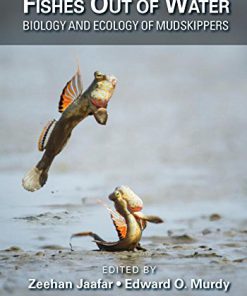Water Bears The Biology of Tardigrades 1st edition by Ralph Schill ISBN 3319957012 9783319957012
$50.00 Original price was: $50.00.$25.00Current price is: $25.00.
Water Bears The Biology of Tardigrades 1st edition by Ralph Schill – Ebook PDF Instant Download/Delivery: 3319957012, 978-3319957012
Full download Water Bears The Biology of Tardigrades 1st Edition after payment

Product details:
ISBN 10: 3319957012
ISBN 13: 978- 3319957012
Author: Ralph Schill
Offering extensive information on tardigrades, this volume begins with a chapter on the history of tardigrades, from the first description by Goeze in 1773, until 1929, when the most comprehensive monographic approach by E. Marcus was published. Tardigrades’ organ systems, including their integument, body cavity, digestive, muscular, nervous and reproductive systems, as well as their overall external morphology, are summarized in the second chapter. Subsequent chapters present the current state of knowledge on tardigrade phylogeny, biogeography, paleontology, cytology and cytogenetics. In addition, the book provides insights into the ecology of tardigrades in marine, freshwater and terrestrial habitats. The reproduction, development and life cycles are summarized and the extraordinary environmental adaptations of encystment and cyclomorphosis, desiccation tolerance, freezing tolerance and radiation tolerance are discussed in detail. Further chapters provide an overview of key approaches in molecular tardigrade studies and describe techniques for sampling and sample processing. The book closes with a list of tardigrade taxa up to a sub-generic level, including the type species of each genus, the numbers of lower taxa in each taxon, and the main environments in which the taxa were found.
Given its depth of coverage, the volume offers an invaluable resource for scientists from various disciplines who plan to research tardigrades, and for all others who are interested in these fascinating animals.
Water Bears The Biology of Tardigrades 1st Table of contents:
1. From Johann August Ephraim Goeze to Ernst Marcus – A Ramble through the History of Early Tardigrade Research (1773 until 1929)
-
Johann August Ephraim Goeze (1773): Goeze was the first to describe tardigrades scientifically. He initially called them “water bears” or “little water animals,” based on their appearance and movement, though his work was limited by the microscope technology of the time.
-
Important Milestones:
- 1770s to 1800s: Early researchers, including Goeze and later scientists like Karl von Nägeli and Augustus Quatrefages, continued to observe tardigrades, improving the understanding of their microscopic structure and behavior.
- Ernst Marcus (1929): Marcus made significant contributions to the understanding of tardigrade morphology, anatomy, and taxonomy. His work, along with his contemporaries, led to the establishment of tardigrades as a distinct phylum within the animal kingdom.
2. Morphology and Functional Anatomy
Tardigrades are microscopic, water-dwelling animals with a unique, segmented body structure, often characterized by:
- Body Structure: The body consists of four segments, each with a pair of legs, which are used for movement. They have a soft body with a cuticle that is periodically shed.
- Functional Anatomy: Key functional features include:
- Stylet: A specialized structure used to pierce plant or animal cells for feeding.
- Cryptobiosis: Tardigrades are well-known for their ability to enter a state of suspended animation called cryptobiosis, which enables them to survive extreme conditions, including dehydration, freezing, and high radiation.
3. Phylogeny and Integrative Taxonomy of Tardigrada
- Taxonomy: The classification of tardigrades has evolved over time. Initially thought to be related to arthropods, their unique features led to the recognition of tardigrades as a distinct phylum.
- Integrative Taxonomy: The integration of molecular genetics with traditional morphology has clarified the evolutionary relationships within the phylum, showing that tardigrades are more closely related to arthropods and onychophorans than previously thought.
4. Tardigrade Biogeography
- Distribution: Tardigrades are found in a variety of environments worldwide, including the deep sea, high mountain ranges, and polar regions. Their widespread distribution reflects their adaptability and resilience, especially given their cryptobiotic abilities.
- Habitat Preferences: Most tardigrades live in mosses and lichens, but they can also be found in soil, leaf litter, and aquatic environments.
- Biogeographical Patterns: Tardigrades’ distribution is influenced by climate, altitude, and the availability of suitable habitats.
5. Paleontology and Molecular Dating
- Paleontological Evidence: Tardigrades are known from fossils dating back to the Cambrian period, about 500 million years ago. Fossilized tardigrades offer insight into the early evolutionary history of this group.
- Molecular Dating: Advances in molecular biology, such as DNA sequencing, have allowed researchers to estimate the divergence time of various tardigrade lineages, providing a more accurate picture of their evolutionary history.
6. Cytology and Cytogenetics
- Cytology: The study of cell structures in tardigrades has revealed unique features, including the presence of specialized organelles and unique cell division processes.
- Cytogenetics: Tardigrades exhibit interesting genetic traits, such as a reduced number of chromosomes in some species. Research into their genetic makeup has increased understanding of their resistance mechanisms, particularly their ability to survive in a cryptobiotic state.
People also search for Water Bears The Biology of Tardigrades 1st:
water bears the biology of tardigrades pdf
how do water bears survive
why are water bears called water bears
the water bear is best described as
facts about the water bear
Tags:
Ralph Schill,Water Bears,Biology,Tardigrades 1st
You may also like…
Romance - Paranormal Romance
Biology and other natural sciences - Biology
Medicine - Natural Medicine
Cancer and the New Biology of Water 1st edition by Thomas Cowan ISBN 1603588825 9781603588829
Computers - Computer Business & Culture
Computers - Programming
A First Course in Systems Biology 2nd Edition by Eberhard Voit ISBN 9781351332934 1351332937
Politics & Philosophy - Anthropology
Science Fiction - Dystopian Fiction
Science (General)
Fishes out of water : biology and ecology of mudskippers 1st Edition Zeehan Jaafar 9781315119861












